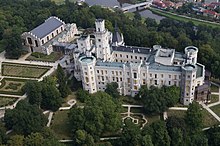world.wikisort.org - Czech
Hluboká nad Vltavou (Czech pronunciation: [ˈɦlubokaː ˈnad vl̩tavou]; until 1885 Podhrad, German: Frauenberg) is a town in České Budějovice District in the South Bohemian Region of the Czech Republic. It has about 5,400 inhabitants. The town is known for the Hluboká Castle.
Hluboká nad Vltavou | |
|---|---|
Town | |
 Centre of the town with Church of Saint John of Nepomuk | |
 Flag  Coat of arms | |
 Hluboká nad Vltavou Location in the Czech Republic | |
| Coordinates: 49°3′5″N 14°26′9″E | |
| Country | |
| Region | South Bohemian |
| District | České Budějovice |
| First mentioned | 1378 |
| Government | |
| • Mayor | Tomáš Jirsa |
| Area | |
| • Total | 91.11 km2 (35.18 sq mi) |
| Elevation | 394 m (1,293 ft) |
| Population (2022-01-01)[1] | |
| • Total | 5,353 |
| • Density | 59/km2 (150/sq mi) |
| Time zone | UTC+1 (CET) |
| • Summer (DST) | UTC+2 (CEST) |
| Postal code | 373 41 |
| Website | www |
Administrative parts
Villages of Bavorovice, Buzkov, Hroznějovice, Jaroslavice, Jeznice, Kostelec, Líšnice, Munice, Poněšice and Purkarec are administrative parts of Všemyslice.
Geography
Hluboká nad Vltavou is situated about 7 kilometres (4 mi) north of České Budějovice, on both banks of the Vltava river. There are many fish ponds in the municipal territory. The town itself lies on the shore of the largest of them, which is Munický pond with an area of 108 hectares (270 acres).[2]
Hluboká nad Vltavou lies mostly in the Tábor Uplands, but the southern part with the ponds lies in the České Budějovice Basin, and the eastern part extends into the Třeboň Basin. The northern part of the large municipal territory is covered by forests. The highest point is the hill Velký Kameník with 575 metres (1,886 ft) above sea level.
History
History of the town is connected with a castle, which was founded together with the city of České Budějovice by King Ottokar II of Bohemia on a rocky promontory above the Vltava river. A settlement was founded under the castle and named Podhrad (literally meaning "Undercastle").[3]
The castle later passed to the Vítkovci dynasty. Again purchased by the royal chamber in the 14th century, it was a favourite residence of Emperor Charles IV, who often visited the castle when residing in České Budějovice.[citation needed]
Held by the local noble Vilém II of Pernštejn from 1490 onwards, castle and town prospered. In 1496, the settlement was promoted to a market town.[3]
Though seized by French forces in the Thirty Years' War, the acquisition by the Schwarzenberg family in 1661 brought even greater wealth to the area. After a blaze in 1742, the medieval fortress was slighted and rebuilt into a Renaissance castle, then between 1839 and 1871 into the current Neo-Gothic castle.
A Jewish community (Qahal) arose in the late 17th century, however, a synagogue was not erected until 1907.[citation needed]
The present-day municipality arose in 1850. The majority of the population was Czech-speaking. The town was renamed after the castle Hluboká Castle in 1885. In 1907, Hluboká became a town by decision of Franz Joseph I.[3]
Demographics
|
|
| ||||||||||||||||||||||||||||||||||||||||||||||||||||||
| Source: Censuses[4][5] | ||||||||||||||||||||||||||||||||||||||||||||||||||||||||
Education
The Townshend International School has been based in the town since 1992.
Sights


The main landmark of Hluboká nad Vltavou is the Tudor-style Hluboká Castle. Every year it is one of the most visited castles in the country.[6]
The second significant castle in Hluboká nad Vltavou is Ohrada Castle. It is a Baroque hunting castle built in 1708–1713. In 1842, the Hunting Museum, one of the oldest museums in the country, was established here. It still exist under the name Museum of Forestry, Hunting and Fishing, and is administered by National Museum of Agriculture in Prague.[7]
Next to the castle there is a zoological garden, colloquially known as Ohrada Zoo. It breeds about 300 species of animals.
Notable people
- Alfred I, Prince of Windisch-Grätz (1787–1862), Austrian general, married Princess Eleonore of Schwarzenberg here on 15 June 1817
- František Mareš (1857–1942), professor and politician; died here
- Eduard Bloch (1872–1945), doctor of Adolf Hitler's family until 1907
- Miroslav Dvořák (1951–2008), ice hockey player
- Martin Latka (born 1984), footballer
Twin towns – sister cities
Hluboká nad Vltavou is twinned with:[8]
 Bolligen, Switzerland
Bolligen, Switzerland Grein, Austria
Grein, Austria Neustadt an der Aisch, Germany
Neustadt an der Aisch, Germany
References
- "Population of Municipalities – 1 January 2022". Czech Statistical Office. 2022-04-29.
- "Munický rybník" (in Czech). Klub českých turistů Tábor. Retrieved 2021-08-30.
- "Hluboká nad Vltavou" (in Czech). Město Hluboká nad Vltavou. Retrieved 2021-08-30.
- "Historický lexikon obcí České republiky 1869–2011 – Okres České Budějovice" (in Czech). Czech Statistical Office. 2015-12-21. pp. 7–8.
- "Population Census 2021: Population by sex". Public Database. Czech Statistical Office. 2021-03-27.
- "Nejnavštěvovanější místa v kategorii Hrady a zámky: Pražský hrad, Český Krumlov a Hluboká nad Vltavou" (in Czech). Kudy z nudy. 2021-05-14. Retrieved 2021-08-30.
- "Zámek Ohrada – Muzeum lesnictví, myslivosti a rybářství v Hluboké nad Vltavou" (in Czech). Kudy z nudy. Retrieved 2021-08-30.
- "Partnerská města" (in Czech). Město Hluboká nad Vltavou. Retrieved 2020-08-20.
External links
- Official website
- Official website – Portal for citizens (in Czech)
- Tourist portal
Другой контент может иметь иную лицензию. Перед использованием материалов сайта WikiSort.org внимательно изучите правила лицензирования конкретных элементов наполнения сайта.
WikiSort.org - проект по пересортировке и дополнению контента Википедии
